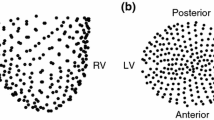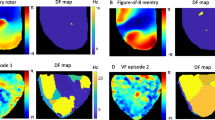Abstract
Few techniques have been developed for deriving quantitative measures of activation patterns during ventricular fibrillation (VF). Such measures have many potential applications, for example, assessing the effects of time, drugs, or electrical interventions. We have developed a new framework for quantifying VF patterns as mapped from an array of ≈500 unipolar electrodes. Individual activation wavefronts are isolated from one another using an algorithm that groups together adjacent active electrogram samples (dV/dt <−0.5 V/sec). Contacts between wavefronts are detected; these include fractionations, in which a single wavefront breaks into multiple wavefronts, and collisions, in which multiple wavefronts coalesce to form a new wavefront. The timing and contact relationships between wavefronts are summarized as a directed graph. From this model of the VF episode, we derive several parameters: number of wavefronts number of fractionations, number of collisions, mean wavefront size, mean area swept out, and mean duration. As an example of this analysis, we computed these parameters in six open-chest pigs at 5, 10, 15, and 20 sec after electrical induction of VF. The number of wavefronts and the number of collisions decreased, whereas the mean wavefront size and mean area swept out increased during this period. These results are consistent with previous studies showing a recovery of organization during the first minute of VF.
Similar content being viewed by others
References
Bayly, P. V., E. E. Johnson, S. F. Idriss, R. E. Ideker, and W. M. Smith. Efficient electrode spacing for examining spatial organization during ventricular fibrillation.IEEE Trans. Biomed. Eng. 40:1060–1066, 1993.
Bayly, P. V., E. E. Johnson, P. D. Wolf, H. S. Greenside, W. M. Smith, and R. E. Ideker. A quantitative measurement of spatial order in ventricular fibrillation.J. Cardiovasc. Electrophysiol. 4: 533–546, 1993.
Bayly, P. V., E. E. Johnson, P. D. Wolf, W. M., Smith, and R. E. Ideker. Measuring changing spatial complexity in VF using the Karhunen-Loeve decomposition of 506-channel epicardial data. In: Proceedings of Computers in Cardiology, edited by A. Murray and R. Arzbaecher. London: IEEE Computer Society Press, 1993, pp. 53–56.
Berbari, E. J., P. Lander, B. J. Scherlag, R. Lazara, and D. B. Gesesowitz. Ambiguities of epicardial mapping.J. Electrocardiol. 24(Suppl.): 16–20, 1992.
Bollacker, K. D., E. V. Simpson, R. E. Hillsley, S. M. Blanchard, R. J. Gerstle, G. P. Walcott, R. L. Callihan, M. C. King, W. M. Smith, and R. E. Ideker. An automated technique for identification and analysis of activation fronts in a two-dimensional electrogram array.Comput. Biomed. Res. 27:229–244, 1994.
Chachra, V., P. M. Ghare, and J. M. Moore. Applications of Graph Theory Algorithms. New York: North Holland, 1979.
Chen P. S., P. D. Wolf, and R. E. Ideker. Mechanism of cardiac defibrillation. A different point of view.Circulation 84:913–919, 1991.
Damle, R. S., N. M. Kanaan, N. S. Robinson, Y.-Z. Ge, J. J. Goldberger, and A. H. Kadish. Spatial and temporal linking of epicardial activation directions during ventricular fibrillation in dogs: evidence for underlying organization.Circulation 86: 1547–1558, 1992.
Damle, R. S., N. S. Robinson, D. Z. Ye, S. I. Roth, R. Greene, J. J. Goldberger, and A. H. Kadish. Electrical activation during ventricular fibrillation in the subacute and chronic phases of healing canine myocardial infarction.Circulation 92:535–545, 1995.
Ershler, P.R., and R. L. Lux. Derivative mapping in the study of activation sequence during ventricular arrhythmias. In: Proceedings of Computers in Cardiology, edited by K. L. Ripley. Washington, DC: IEEE Computer Society Press, 1986, pp. 623–624.
Hamming, R. W. Digital Filters (third edition). Englewood Cliffs, NJ: Prentice Hall, 1989.
Hillsley, R. E., K. D. Bollacker, E. V. Simpson, D. L. Rollins, M. D. Yarger, P. D. Wolf, W. M. Smith, and R. E. Ideker. Alteration of ventricular fibrillation by propranolol and isoproterenol detected by epicardial mapping with 506 electrodes.J. Cardiovasc. Electrophysiol. 6:471–485, 1995.
Ideker, R. E., W. M. Smith, S. M. Blanchard, S. L. Reiser, E. V. Simpson, P. D. Wolf, and N. D. Danieley. The assumptions of isochronal cardiac mapping.PACE 12: 456–478, 1989.
Ideker, R. E., P. D. Wolf, E. Simpson, E. E. Johnson, S. B. Blanchard, and W. M. Smith. The ideal cardiac mapping system. In: Cardiac mapping, edited by M. Shenasa, M. Borggrefe, and G. Briethardt. Mount Kisco, NY: Futura Publishing Co., 1993, pp. 649–653.
Johnson, E. E., S. F. Idriss, C. Cabo, S. B. Melnick, W. M. Smith, and R. E. Ideker. Evidence that organization increases during the first minute of ventricular fibrillation in pigs mapped with closely spaced electrodes.J. Am. Coll. Cardiol. 19:90A, 1992.
KenKnight, B. H., P. V. Bayly, R. J. Gerstle, D. L. Rollins, P. D. Wolf, W. M. Smith, and R. E. Ideker. Regional capture of fibrillating ventricular myocardium. Evidence of an excitable gap.Circ. Res. 77: 849–855, 1995.
Laxer, C., C. Alferness, W. M. Smith, and R. E. Ideker. The use of computer animation of mapped cardiac potentials in studying electrical conduction properties of arrhythmias. In: Proceedings of Computers in Cardiology, edited by A. Murray and K. L. Ripley, Chicago, IL, IEEE Computer Society Press, 1990, pp. 23–26.
Martel, S., S. Lafontaine, D. Bullivant, I. W. Hunter, and P. J. Hunter. A hardware object oriented cardiac mapping system. In: Proceedings of IEEE Engineering in Medicine and Biology Society, Montreal, 1995.
Mastrototaro, J. J., H. Z. Massoud, T. C. Pilkington, and R. E. Ideker. Rigid and flexible thin-film multielectrode arrays for transmural cardiac recording.IEEE Trans. Biomed. Eng. 39: 271–279, 1992.
Norusis, M. J.. SPSS Advanced Statistics, Chicago: SPSS, Inc., 1994.
Poole, J. E., and G. H. Bardy, Studden cardiac death. In: Cardiac electrophysiology. From cell to bedside, edited by D. P. Zipes and J. Jalife. Philadelphia: W. B. Saunders, 1995, pp. 812–832.
Rogers, J. M., R. E. Ideker, and W. M. Smith. A new method for quantifying the motion of epicardial activation wavefronts. In: Proceedings of Computers in Cardiology, edited by M. Murray and R. Arzbaecher, Vienna, Austria: IEEE, 1995, pp. 797–800.
Smith, W. M., P. D. Wolf, E. V. Simpson, N. D. Danieley, and R. E. Ideker. Mapping ventricular fibrillation and defibrillation. In: Cardiac mapping, edited by M. Shenasa, M. Borggrefe, and G. Breithardt. Mount Kisco, NY: Futura Publishing Co., 1993, pp. 251–260.
Witkowski, F. X. and P. A. Penkoske. Activation patterns during ventricular fibrillation.Ann. N.Y. Acad. Sci. 591:219–231, 1990.
Witkowski, F. X., P. A. Penkoske, and R. Plonsey. Mechanism of cardiac defibrillation in open-chest dogs with unipolar DC-coupled simultaneous activation and shock potential recordings.Circulation 82: 244–260, 1990.
Wolf, P. D., D. E. Rollins, E. V. Simpson, W. M. Smith, and R. E. Ideker, A 528 channel system for the acquisition and display of defibrillation and electrocardiographic potentials. In: Proceedings of Computers in Cardiology, edited by M. Murray and R. Arzbaecher. London: IEEE Computer Society Press, 1993, pp. 125–128.
Author information
Authors and Affiliations
Rights and permissions
About this article
Cite this article
Rogers, J.M., Usui, M., KenKnight, B.H. et al. A quantitative framework for analyzing epicardial activation patterns during ventricular fibrillation. Ann Biomed Eng 25, 749–760 (1997). https://doi.org/10.1007/BF02684159
Received:
Revised:
Accepted:
Issue Date:
DOI: https://doi.org/10.1007/BF02684159




